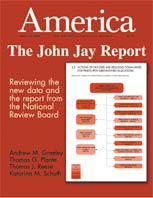The John Jay Report
Signs of the Times: John Jay Report
Undergoing Revisions
America Magazine
March 22, 2004
http://www.americamagazine.org/gettext.cfm?
articleTypeID=29&textID=3492&issueID=478
[See all the articles in America's feature on the John Jay Report:
• A
Bad Day for the Bishops, by Andrew M. Greeley
• Another
Aftershock, by Thomas G. Plante
• Facts,
Myths and Questions, by Thomas J. Reese
• Seminaries
and the Sexual Abuse Crisis, by Katarina M. Schuth
• John
Jay Report Undergoing Revisions
See also the text
of the John Jay report.]
Errors in the report prepared by the John Jay College of Criminal Justice
on sexual abuse by Catholic clergy leave unanswered one of the central
questions the report was supposed to answer: How did church leaders respond
to allegations of sexual abuse? The report has been removed from the World
Wide Web site of the U.S. Conference of Catholic Bishops following discovery
of errors in the section describing how bishops and religious superiors
dealt with allegations of sexual abuse. There is no indication that other
sections of the report have significant errors. At press time the report
was still available on the John Jay College Web site (www.johnjaycollege.edu).
 |
Page 83 of the report contained a graphic (Fig. 5.3.1), showing how bishops responded to “substantiated” allegations of sexual abuse, but the figure contained erroneous data. The data were meant to show in what percentage of cases the diocese or religious community reprimanded an accused priest and returned him to ministry, or assigned him to medical leave or took no action, etc. But the individual percentages did not match the raw numbers given in the figure. [Note from BishopAccountability.org: See the original Figure 5.3.1, which was last modified by the John Jay team on February 24, 2004 and posted on February 27, 2004, and the revised version of the figure as finalized on April 16, 2004. See also complete copies of the original John Jay report as it was released on February 27, 2004, and the revised John Jay report, as finalized on April 16, 2004.]
America discovered errors in the graphic while preparing it for use on the cover of this week’s issue. An official at the U.S. Bishops Conference who was asked why the percentages and the raw numbers in the figure did not match, expressed surprise and referred the questioner to the John Jay College of Criminal Justice, which prepared the report. Within hours of America’s query, all but the executive summary of the report was removed from the bishops’ Web site and replaced by a notice stating that the “report is undergoing final editing” and will be available in late March.
Margaret L. Smith, data analyst for the John Jay College research team, acknowledged in response to questions from America that Fig. 5.3.1. showed incorrect data. At press time, no revision was available.
When the John Jay report was released on Feb. 27, the researchers indicated that they had been under “a very tight time schedule for completion of the project” and that despite “rigorously” checking the data, “we anticipate that some minor errors may remain.”
What Are ‘Substantiated’ Allegations?
Differing definitions of the word “substantiated” appear to
have caused problems for researchers at the John Jay College of Criminal
Justice as they analyzed data from the survey questionnaire sent to diocesan
officials to collect information on sexual abuse by clergy in the United
States. The investigators discovered from notes on the returned questionnaires
that respondents had used various criteria for determining whether an
allegation was “substantiated” or not. Some may have taken
“substantiated” to mean “credible,” others “proven
beyond a reasonable doubt” or something else. No written definition
of the term had been provided to diocesan officials by the researchers.
In addition, this question was asked only about cases investigated by
the diocese, not about all cases.
The report released on Feb. 27 did not contain any information on what percentage of the allegations were investigated by dioceses or what percentage were substantiated, even though these questions were asked in the questionnaire given to diocesan officials.
The principal investigator for the report at John Jay College, Karen Terry, told Catholic News Service that according to the survey data, church officials substantiated allegations against about two-thirds of the 4,392 clergymen accused of sexual abuse of minors during the 52-year time period from 1950 to 2002. Terry said the fact that some of the allegations were unsubstantiated does not mean they were disproved. Margaret Smith, the study’s data analyst, said that the two-thirds figure was based on a combination of factors involving cross-checking with other questionnaires to see, for instance, if disciplinary actions were taken against priests, even though no investigation results were reported.
Data provided to America by John Jay researchers seems to indicate that 65 percent of the allegations were investigated by diocesan officials, and that of this number 65 percent were judged “substantiated” by those officials, although the survey questionnaire had left the word undefined. The confusion over “substantiated” adds to the problems of Fig. 5.3.1, which was meant to report the response of bishops to “substantiated” allegations.
Original material copyright © BishopAccountability.org 2004. Reproduce freely with attribution.